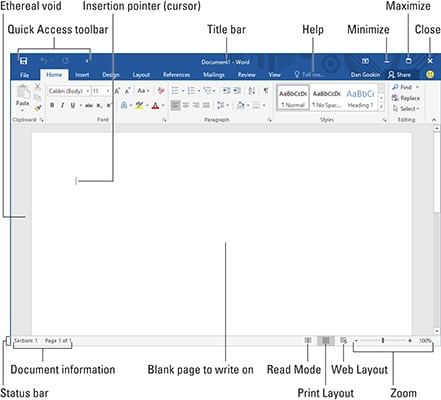

The objective of this post is to show you how data coming from *wherever* can be automatically inserted into a new Word doc. Your Flow could be getting this information from a SharePoint list form, from Salesforce, or PowerApps.
#MS WORD 2016 QUICK PARTS MANUAL#
In your manual trigger, create input parameters for each of the values you’re using in the document as quick parts.Īgain, this is a simple example. Your trigger can be whatever you’d like it to be, but for this simple example, I’ll use a manual trigger, a button.Save your file in place, and close Word.Note that my font here is red, but is typically gray by default. Go through the process of putting your cursor in your document in each spot that the value belongs, and insert Quick Parts wherever you need them.Click a property to insert it in your document. From the list of document properties, you’ll see your library’s metadata. Click Quick Parts, and choose Document Property. Once your document is in the library, then open it in MS Word.

 Create a new Word document in that library, or if you already have an existing document to use as a template, upload it to your new library. In my example, I’m adding these text columns: Customer, Hours, TaxID Create a document library in SharePoint, and add new columns in the library, for each piece of information that you’d like to insert into your documents. This post is really just showing a way that they can be used in conjunction with Flow. They’ve been around since SharePoint / Office 2010. This course is designed for students who wish to use Microsoft Word to create and modify complex documents and use tools that allow them to customize those documents.What does that title mean? Translation: Create a Microsoft Flow that will let people fill out a form and place the field values in specific spots of a Word document, so that it looks like a filled-out legal document (or any kind of document). In addition, you should be able to navigate and perform common tasks in Word, such as opening, viewing, editing, and saving documents formatting text and paragraphs format the overall appearance of a page and create lists and tables. To ensure your success in this course, you should have end-user skills with any current version of Windows®, including being able to start programs, switch between programs, locate saved files, close programs, and access websites using a web browser. This course covers Microsoft Office Specialist Program exam objectives to help you prepare for the Exam 77-725. In this course, you will learn to create and modify complex documents and use tools that allow you to customize those documents such as: organize content using tables and charts, customize formats using styles and themes, insert content using quick parts, use templates to automate document formatting, control the flow of a document, simplify and manage long documents and use mail merge to create letters, envelopes, and labels.
Create a new Word document in that library, or if you already have an existing document to use as a template, upload it to your new library. In my example, I’m adding these text columns: Customer, Hours, TaxID Create a document library in SharePoint, and add new columns in the library, for each piece of information that you’d like to insert into your documents. This post is really just showing a way that they can be used in conjunction with Flow. They’ve been around since SharePoint / Office 2010. This course is designed for students who wish to use Microsoft Word to create and modify complex documents and use tools that allow them to customize those documents.What does that title mean? Translation: Create a Microsoft Flow that will let people fill out a form and place the field values in specific spots of a Word document, so that it looks like a filled-out legal document (or any kind of document). In addition, you should be able to navigate and perform common tasks in Word, such as opening, viewing, editing, and saving documents formatting text and paragraphs format the overall appearance of a page and create lists and tables. To ensure your success in this course, you should have end-user skills with any current version of Windows®, including being able to start programs, switch between programs, locate saved files, close programs, and access websites using a web browser. This course covers Microsoft Office Specialist Program exam objectives to help you prepare for the Exam 77-725. In this course, you will learn to create and modify complex documents and use tools that allow you to customize those documents such as: organize content using tables and charts, customize formats using styles and themes, insert content using quick parts, use templates to automate document formatting, control the flow of a document, simplify and manage long documents and use mail merge to create letters, envelopes, and labels. 
Use mail merge to create letters, envelopes, and labels.Use templates to automate document formatting.Customize formats using styles and themes.Organize content using tables and charts.By actively participating in this course, you will learn about the following:








 0 kommentar(er)
0 kommentar(er)
